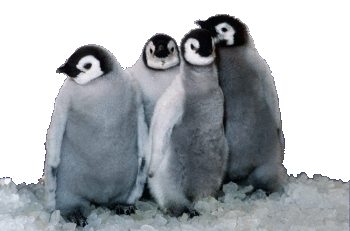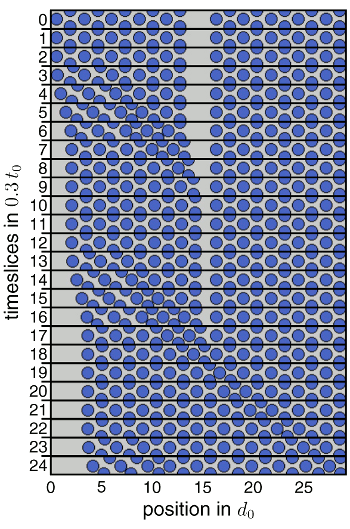Doing the Penguin Huddle
January 20, 2014
Penguins have always been popular
cartoon characters. In
my generation, it was
Chilly Willy, who joined
Woody Woodpecker in the
Walter Lantz anthropomorphic cartoon character repertoire. Chilly lived in
Alaska, as it was a common misconception that penguins lived at the nearby
North Pole.
Today's children are more
sophisticated, and Chilly Willy would play well only with the
pre-kindergarten crowd. That's why cartoon penguins have morphed into things like
The Penguins of Madagascar. I rarely use the word, "sophisticated," since it has traditionally not meant what people think. The Greek
sophists were
philosophers who won their
arguments using
logical ploys, so "sophisticated" had a derogatory sense through the later
19th century.
When I did a
post-doc in
Pittsburgh in the mid-
1970s, their
hockey team, the
Pittsburgh Penguins, was going through some rough times. Recently, they won the 2009
Stanley Cup against the
Detroit Red Wings after losing to them the year before. Now, my favorite penguin is
Tux, the
Linux mascot (see figure).

Tux, the penguin mascot for Linux.
The idea of a penguin mascot for Linux came from its originator, Linus Torvalds. Its first rendition was by Larry Ewing, who created Tux with the popular (and free) image editing program, GIMP.
Tux supposedly has the satisfied look of a well-fed penguin.
(Image by Larry Ewing, Simon Budig and Anja Gerwinski, via Wikimedia Commons.)
It's amazing that penguins can survive in the extreme cold of
Antarctica. A
scientific tabulation of the low
temperatures of that
continent have recently been released by
scientists at
NASA and the
U.S. Geological Survey.[1] Scientists have used
Earth-monitoring satellites, including
Landsat 8, to learn how cold Antarctica really is. In measurements between 2003-2013, they found that one region along a remote
ice plateau had a record low temperature of about -93°
C.[1]
The recorded low temperature of -93.2°C occurred on August 10, 2010. This was just slightly lower than the previously recorded low, at
Vostok Station in
Princess Elizabeth Land, Antarctica, of −89.2°C on July 21, 1983.[1] A world away, in
Greenland, it's only gotten as cold as -75°C. Alaska, the home of Chilly Willy, has only gotten as cold as -62°C.[1]
New Jersey, where I'm writing this, has had a temperature as low as -37°C, but that record was set more than a hundred years ago.

Four Emperor Penguin chicks (Aptenodytes forsteri), part of a National Science Foundation study, in San Diego, 1988. These penguins were native to McMurdo Station, Ross Island, Antarctica.
(Via Wikimedia Commons.)
The idea of
huddling to keep warm has been a plot point of many
television sitcoms. It makes sense from some "
spherical cow"
physics and the fundamental
geometrical principle that an agglomerated mass will present a smaller
area to the outside world than a set of its component masses if separate.
Heat is lost at the
interface between a body and its
environment, and the smaller that area can be made to be, the less heat that will be lost.
Although penguins are not
physicists, they've grasped that principle, and they huddle in extreme weather to keep warm. The huddle pattern is a
triangular lattice. Instead of standing in place, individual penguins will move every 30-60 seconds, and their movement causes adjacent penguins to move, also. Physicists, who are accustomed to analyze the motions of interacting
particles, have decided to use this approach to analyze the motion of penguins in a huddle.[2-3]
Scientists from the
University of Erlangen-Nuremberg (Germany), the
University of Greifswald (Greifswald, Germany), the
Université de Strasbourg (Strasbourg, France),
CNRS (Strasbourg, France), and the
Alfred-Wegener-Institut Helmholtz-Zentrum für Polar- und Meeresforschung (Bremerhaven, Germany) have published their findings in an
open access paper in the
New Journal of Physics.[2]
They were able to create a
mathematical model of penguin motion in a huddle. The model revealed that a motion as small as two
centimeters by a penguin will cause its neighbors to move also to maintain close contact. The motion is much like the stop-go movement of cars in a
traffic jam, and the mathematical model had been used to study traffic jams.[3] Such motion
propagates like a wave throughout the huddle to keep it as dense as possible. This wave motion also aids in merging smaller huddles into larger ones, and it serves to remove
lattice defects.[2-3]

Doing the penguin shuffle.
A kymograph showing the merger of two penguin huddles.
The merger proceeds from top to bottom as the gap is closed, and the wave movement of the leftmost huddle then propagates to the rightmost huddle.
An animation of this is available at the online paper.[2]
(Fig. 5 of Ref. 2, licensed under the Creative Commons Attribution 3.0 license)
The two centimeter threshold distance is just twice the
compression thickness of a penguin's
feather layer, so they penguins pack closely without touching. This is important, since compressing the feather layer lowers its
thermal insulation.[3] The
wave motions in a huddle can originate at any penguin, and it can propagate in any direction, depending on where the gap arises. Says study coauthor,
Daniel Zitterbart of the Alfred Wegener Institute,
"We were really surprised that a traveling wave can be triggered by any penguin in a huddle, rather than penguins on the outside trying to push in... We also found it amazing how two waves, if triggered shortly after each other, merged instead of passing one another, making sure the huddle remains compact."[3]
The emperor penguin is the only
vertebrate species that
breeds in the -50°C temperatures and 200
km/h winds of the Antarctic
winter at their particular
nesting areas.[2-3]
References:
- Scientists Find the Coldest Place on Earth, Voice of America, December 11, 2013.
- R. C. Gerum, B. Fabry, C. Metzner, M. Beaulieu, A. Ancel and D. P. Zitterbart, "The origin of traveling waves in an emperor penguin huddle," New Journal of Physics, vol. 15 (December 2013), Article No. 125022.
- Traffic jams lend insight into emperor penguin huddle, New Journal of Physics Press Release, December 17, 2013.
Permanent Link to this article
Linked Keywords: Penguin; cartoon; characters; my generation; Chilly Willy; Woody Woodpecker; Walter Lantz; anthropomorphic; Alaska; North Pole; sophistication; sophisticated; pre-kindergarten; The Penguins of Madagascar; Sophism; sophist; philosopher; argument; logic; logical ploy; 19th century; postdoctoral research; post-doc; Pittsburgh; 1970s; hockey; Pittsburgh Penguins; Stanley Cup; Detroit Red Wings; Tux; Linux; mascot; Linus Torvalds; Larry Ewing; GIMP; Simon Budig; Wikimedia Commons; Antarctica; science; scientific; table; tabulation; temperature; continent; scientist; NASA; United States Geological Survey; Earth observation satellite; Earth-monitoring satellite; Landsat 8; ice; plateau; Celsius; C; Vostok Station; Princess Elizabeth Land, Antarctica; Greenland; New Jersey; Emperor Penguin; National Science Foundation; San Diego; McMurdo Station; Ross Island; kleptothermy; huddling to keep warm; television sitcom; spherical cow; physics; geometry; geometrical; area; heat; interface; environment; physicist; triangular lattice; particle; University of Erlangen-Nuremberg (Germany); University of Greifswald (Greifswald, Germany); Université de Strasbourg (Strasbourg, France); Centre national de la recherche scientifique; CNRS (Strasbourg, France); Alfred Wegener Institute for Polar and Marine Research; Alfred-Wegener-Institut Helmholtz-Zentrum für Polar- und Meeresforschung (Bremerhaven, Germany); open access journal; academic publishing; scholarly paper; New Journal of Physics; mathematical model; centimeter; traffic jam; wave propagation; lattice defect; kymograph; Creative Commons Attribution 3.0 license; compression; feather; thermal insulation; wave motion; Daniel Zitterbart; vertebrate species; breeding; breed; kilometers per hour; km/h; wind; winter; nest; nesting.